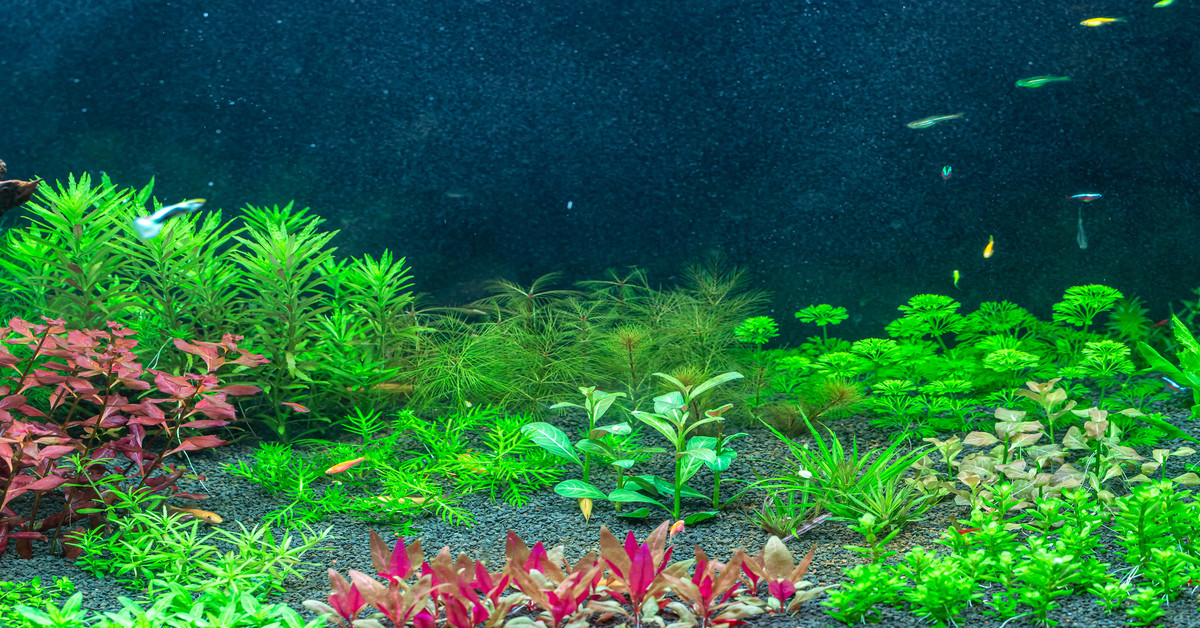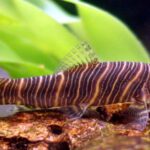For many aquarists, nothing compares to the sight of a beautiful aquarium packed with healthy live plants and suitable decorations. But have you ever imagined building a dream tank with aquarium plants that don’t need light?
In this guide, find out the 35 best low-light aquarium plants for the perfect aquascaping.
In the next paragraphs, we discuss each of these plants in more detail, covering the dos and don’ts of caring for each species and what would make them thrive at home.
1. Bacopa
Bacopa is an extremely versatile aquarium plant that can reach up to 1ft if untrimmed. They have a signature appearance perfect for aquariums, starting with the green-yellow leaves that complement the tank perfectly.
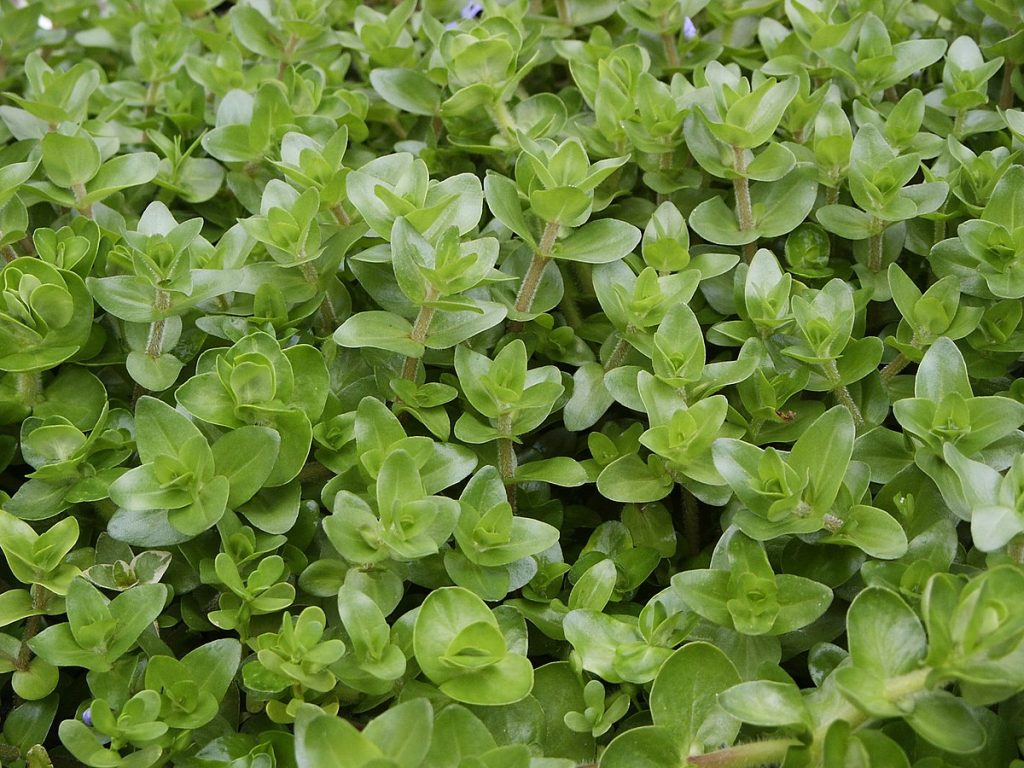
Typically, Bacopa requires little to no maintenance, with one-time trimming just enough to help them grow effortlessly. Bacopa holds a slight advantage with its easier propagation compared to most plants.
It grows anywhere and is perfect for low-light environments. Whether you intend to create beautiful bunches or just a single stalk, you can have it all with the Bacopa inside your tank.
2. African Water Fern
As their name alludes, African Water Fern is found in the Congo River Basin in Western Africa as a medium-sized plant growing up to 22 inches in maturity. Despite being extremely tolerant to low light levels, they have a slow growth rate.
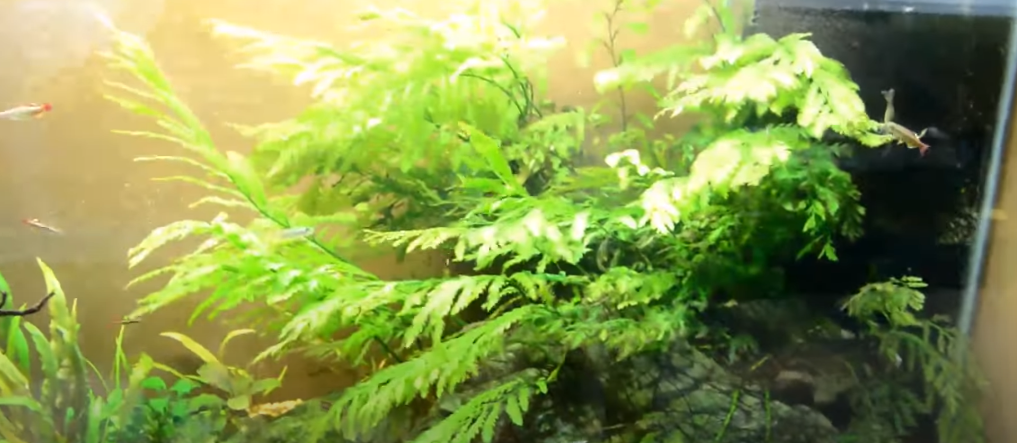
For the perfect growth, African Water Fern requires much more than just planting them inside the tank and hoping they thrive. But that’s not to say they are extremely demanding.
You can attach their rhizomes to your favorite piece of rock or driftwood for perfect anchoring inside the tank. It’s worth reminding that the African Water Ferns are simply not the best option if you keep the Cichlid fish, Koi, and some Goldfish species.
3. Java Fern
The Java Fern is probably the most popular freshwater aquarium plant for a good reason. Typically, Java Ferns have a signature look that extends beyond the bright green coloring.
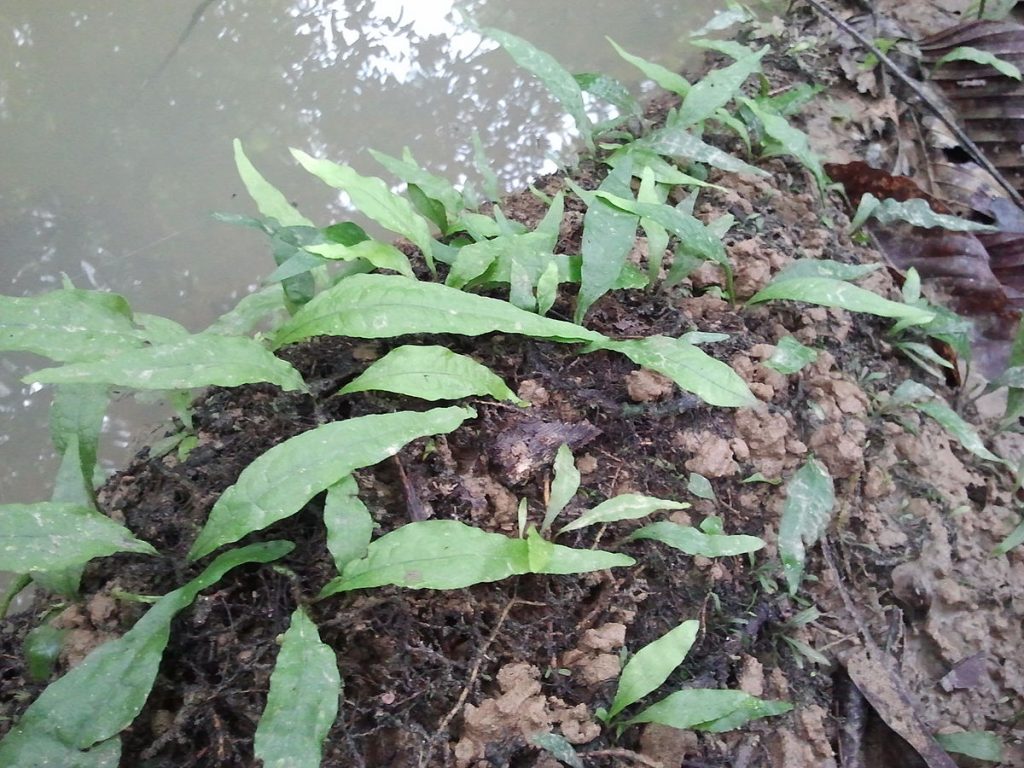
They have pointed leaves and can have a dramatic effect inside the tank with proper anchoring.
As you would expect, the Java Ferns are pretty easy to care for as long as they are grown in the right environment.
A fully grown plant will have a maximum height of 13.5 inches, but the correct care guideline must be followed to reach such sizes. It’s worth reminding that the general appearance of the Java Fern depends on the level of care inside the tank.
A beautiful Java Fern with bright green leaves shows proper care. Conversely, these plants growing in substandard environments with little to no nutrients will have darker leaves with visible clumping.
4. Anubias Barteri
The all-alluring green Anubias Barteri works magic when introduced to the right aquarium. Their typical appearance begins with beautiful leaves, taking on a heart-shaped pattern.
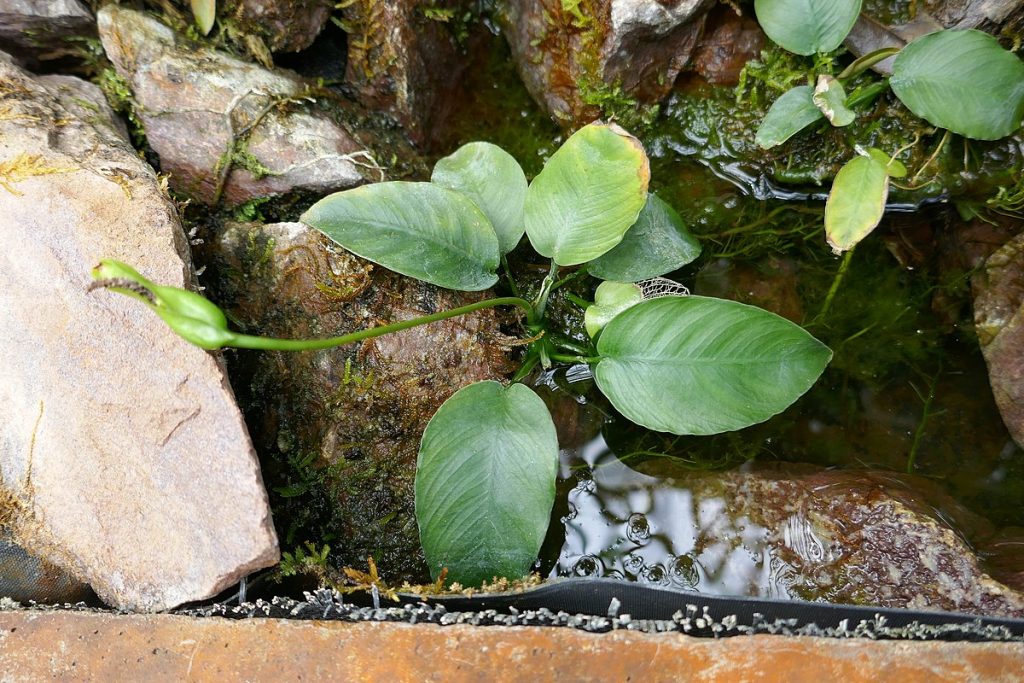
Such leaves cast the perfect shadow inside the aquarium, giving your favorite pet fish the ideal hiding spots at the time of need.
You can’t imagine how deeply we’ve been in love with this fascinating beginner-friendly plant that never grows beyond 16 inches.
While their large leaves can occasionally accumulate huge amounts of algae, that’s also the perfect time to introduce favorite algae-eating fish to complete the symbiotic puzzle.
What’s more, you can use Anubias Barteri as a fully or partially submerged aquarium plant, depending on the design idea. Does it get better than that?
5. Green Hygro
Green Hygro gets enough attention because it’s one of the easiest plants to grow. But the real magic lies in its ease of care, quickly accentuating your tank with proper trimming.
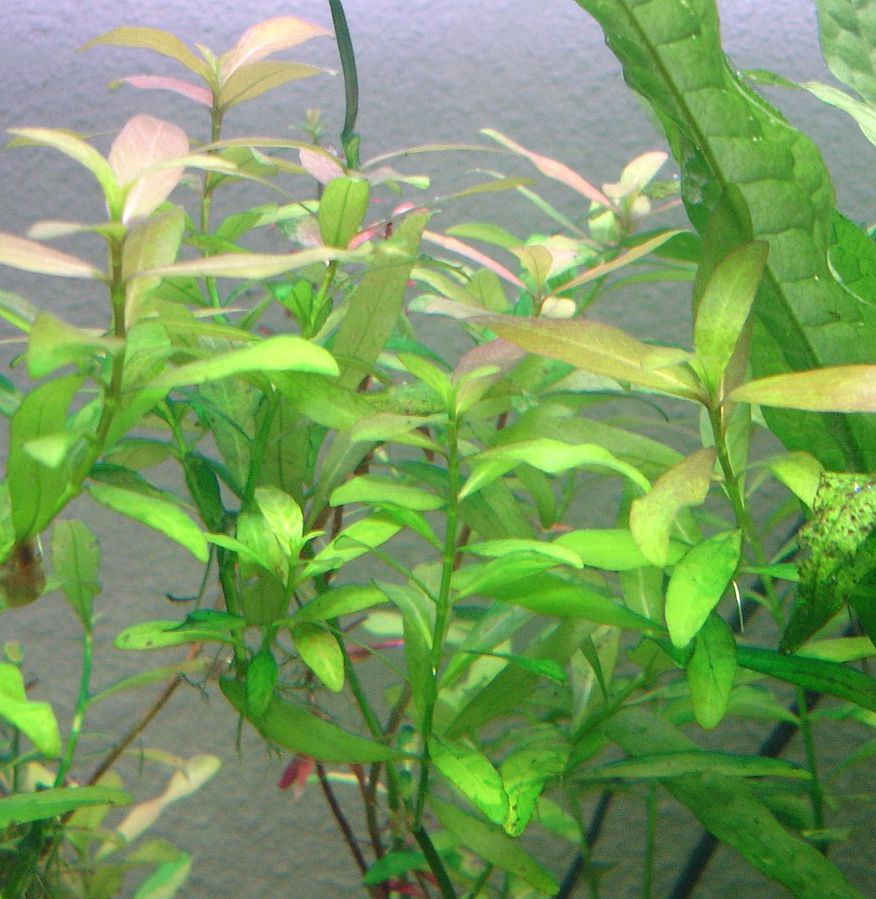
Green Hygro naturally anchors to the preferred substrate, but you can introduce more support depending on the fish species inside the aquarium.
One thing that truly makes Green Hygro such an outstanding aquatic plant is its compatibility. These plants never seem to have any preferences regarding the tank size.
But be wary of expert diggers like the aggressive Cichlids and the industrious Goldfish that sometimes bother your Green Hygro.
Also, don’t forget that they are one of the best low light plants. And as such, exposing them to excessive light can destroy their otherwise stunning look.
6. Sunset Hygro
A visually striking plant endemic to Southeast Asia, Sunset Hygro is an ever-popular low-light aquarium plant that’s easy to grow. They are a fast-growing plant with purple-red leaves protruding from the stalk.
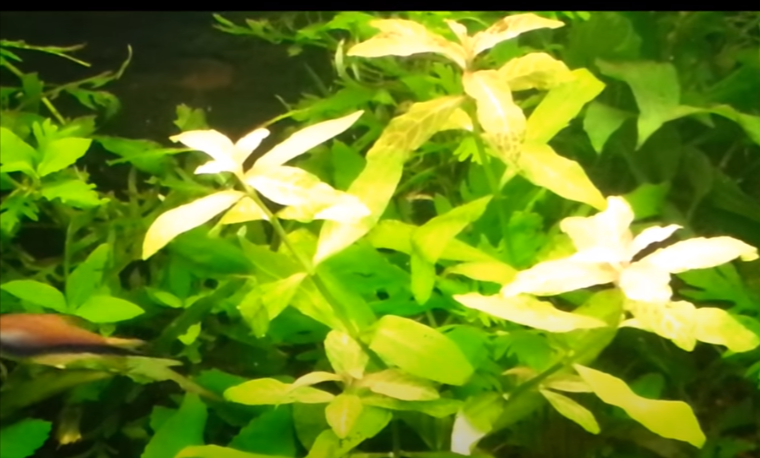
A fully grown Sunset Hygro can reach a maximum height of 16 inches. Of course, that depends on the level of care inside the tank.
Ideally, Sunset Hygros must be planted in the right substrate to ensure they get sufficient nutrients through their leaves and roots.
Given its etymology, Sunset Hygro will prefer warmer waters. But the good news is they are flexible enough to adapt to aquatic life as long as you follow all the care guidelines.
Like all plants on our list, the Asian Sunset Hygros prefer low light even if they are known to tolerate a range of lighting conditions.
7. Anubias Nana
Anubias Nana is the closest thing you will find to the Anubias Barteri, with equally large, green leaves and dark stems. But the bottom line is both of them tolerate low lighting conditions.
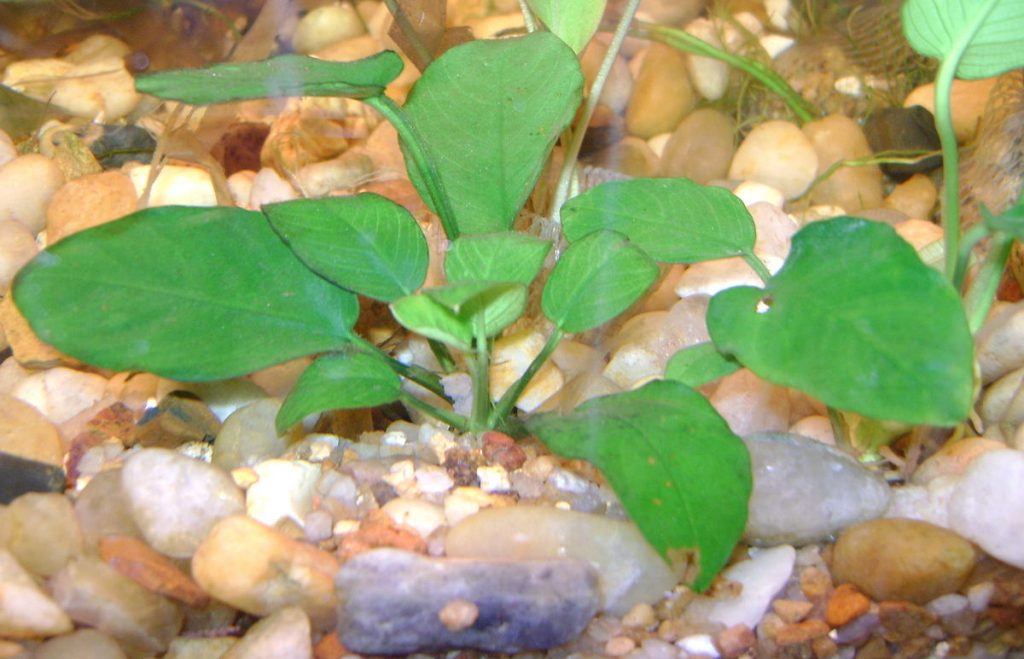
They have a slow growth rate, taking frequent maintenance out of the equation. Like the aforementioned Anubias Barteri, Anubias Nana is a beginner-friendly option that’s so easy to maintain.
They are root feeders that can benefit from fertilizer if the aquarium lacks enough nutrients.
In addition, these plants appreciate fine gravel substrate for proper anchoring and nutrient uptake. And that’s precisely why you should never prioritize a sandy substrate if you grow the A. Nana at home.
8. Marimo Moss Balls
Marimo Moss Balls are probably the weirdest looking freshwater aquarium plants you will ever find. They are the typical green balls perfect for the tank bottom, taking on an odd-looking round shape.

Technically, Marimo Moss Balls are spherical-shaped algae and not actual plants. Still, they are ideal for introducing variety inside the tank.
As you may guess, Marimo Moss Balls are very easy to care for, requiring the least trimming when introduced to a home aquarium. They have the advantage of eliminating harmful nitrates while increasing oxygen levels inside the tank.
While they won’t have significant value as a pet’s habitat, you can introduce them to give your smaller fish multiple resting spots inside the tank.
9. Red Ludwigia
Red Ludwigia is a colorful freshwater plant native to South and Central America.
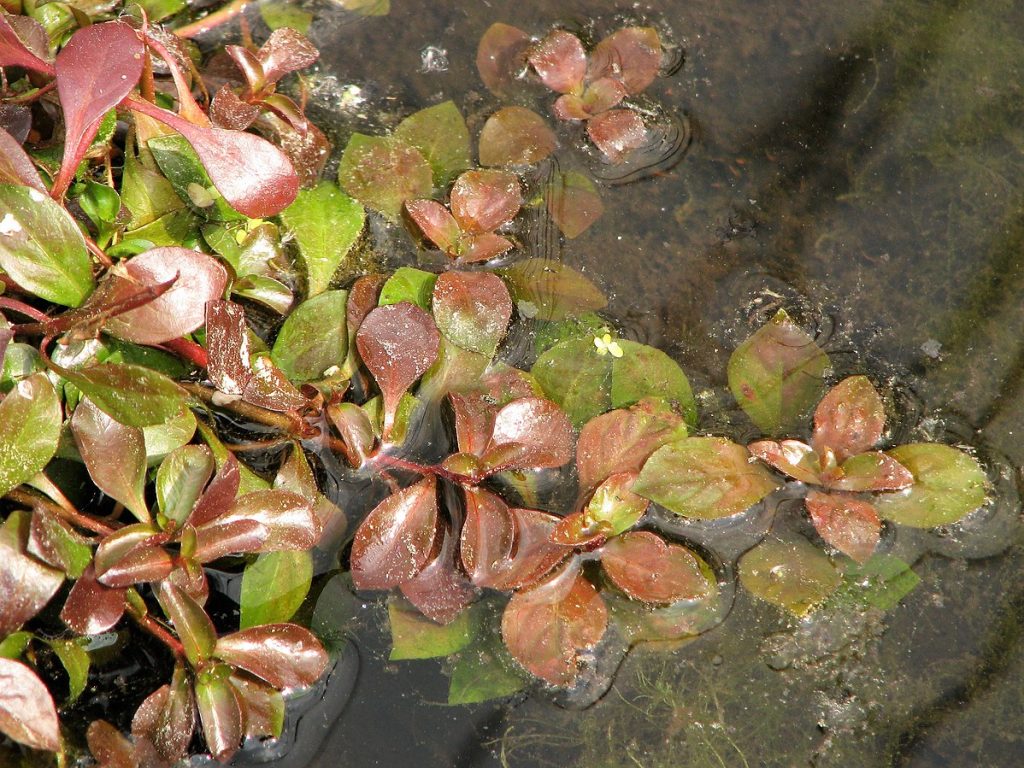
It has broad, deep-red, or dark green to brownish leaves, making it a precious addition to any aquarium. While everybody raves at its decorative effect, these plants are even more appealing if you think about their ease of care.
Once planted inside the tank, Red Ludwigias require minimal trimming.
What’s more, a typical Red Ludwigia is a natural root feeder that readily benefits from a fertilized substrate.
Also, they tolerate a temperature range of 59°F-75°F, reaching up to 20 inches in optimal sizes. We can’t talk about its disadvantages because it has none.
10. Coffee Leaf Anubias
Coffee Leaf Anubias is another low-light aquarium plant that’s hardy, beautiful, and easy to maintain. It is one of the slow-growing aquarium plants that can accumulate huge amounts of algae on its leaves, especially under bright light.
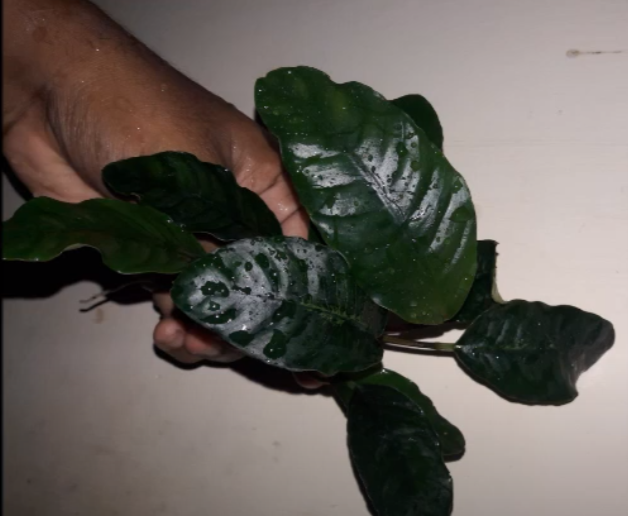
Coffee Leaf Anubias prefer warmer conditions, potentially reaching about 16 inches when the temperature is maintained at 80°F. Like the Red Ludwigia, Coffee Leaf Anubias is a root feeder, easily reaching its maximum size with supplementary iron-rich fertilizer.
While most plants will be bothered by the Cichlid fish and some Goldfish varieties, the Coffee Leaf Anubias is resilient enough to fend off common pests. Most herbivores just don’t like them, but nobody knows why.
11. Micro Crypt
As the name suggests, Micro Crypt is a smaller version of the Crypt plant, famous for its pointed leaves with beautiful green coloring. They only grow up to 6 inches in maximum height, making them the smallest of all the plants in the Crypt genus.
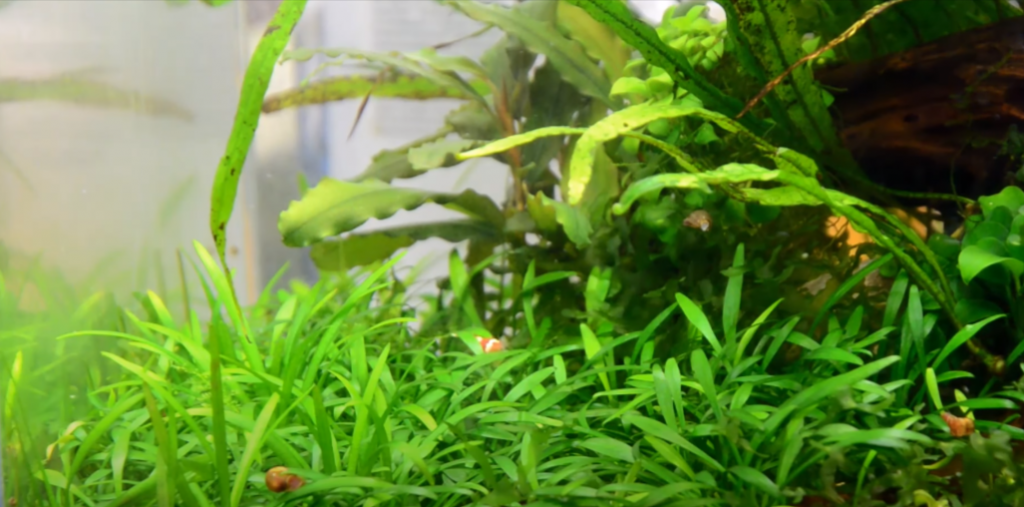
But don’t get it twisted. Despite their small sizes, the Micro Crypts are one of the hardiest aquarium plants, staying healthy as long as it’s sucking up nutrients from the substrate.
They need fertilizers to blossom, with frequent pruning an important part of the overall care plan.
A healthy plant never fails to show inside the tank, spreading across the tank in a neat display of natural beauty. For the same reason, they are best planted with gravel instead of sand.
12. American Waterweed
Of course, American Waterweed comes from North America. And as an ideal aquarium plant, they tolerate low light as long as the rest of the conditions are perfect.
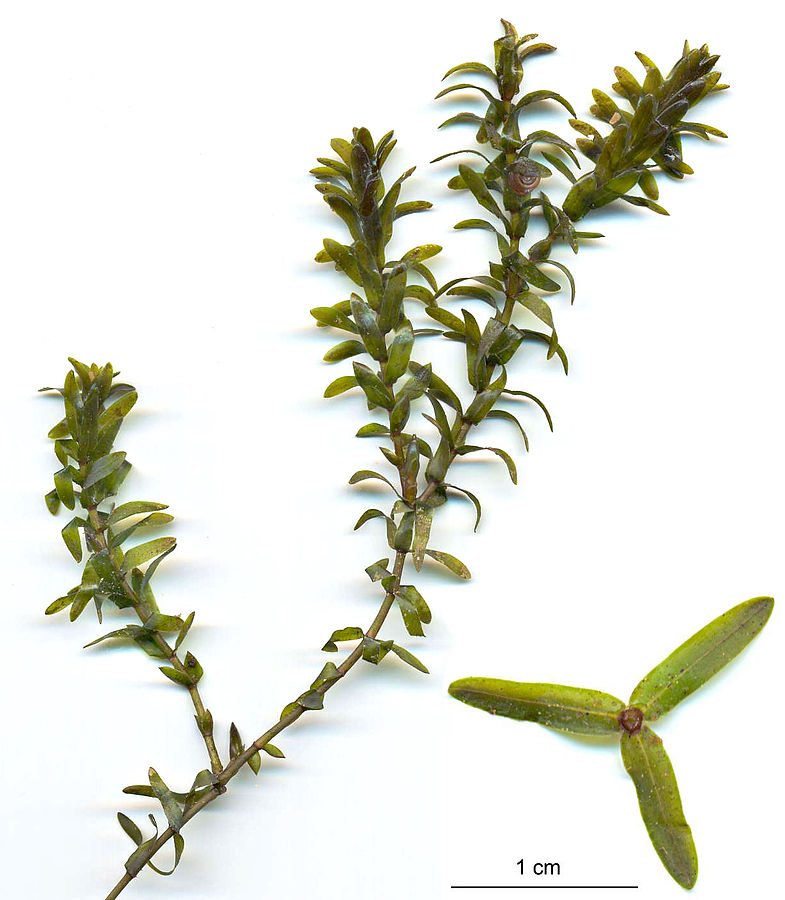
They are similar to the Brazilian Waterweed in many ways. However, they have smaller leaves compared to their South American counterpart.
There are two reasons to introduce the American Waterweed to your aquarium. Firstly, they produce plenty of oxygen to support animal life inside the tank.
Also, they create multiple hiding spots with their large sizes, making your favorite pet fish as secure as they would want to be in captivity.
Don’t consider the American Waterweed if you have a small aquarium, as we’ve always stressed. They enjoy a steady growth rate and may easily outgrow a smaller tank.
On the same note, the American Waterweed isn’t worth considering larger fish that want to compete for space inside the same tank.
13. Java Moss
Every aquarist knows the Java Moss, but perhaps many people don’t know about this lush green Asian plant because it can tolerate low lighting conditions.
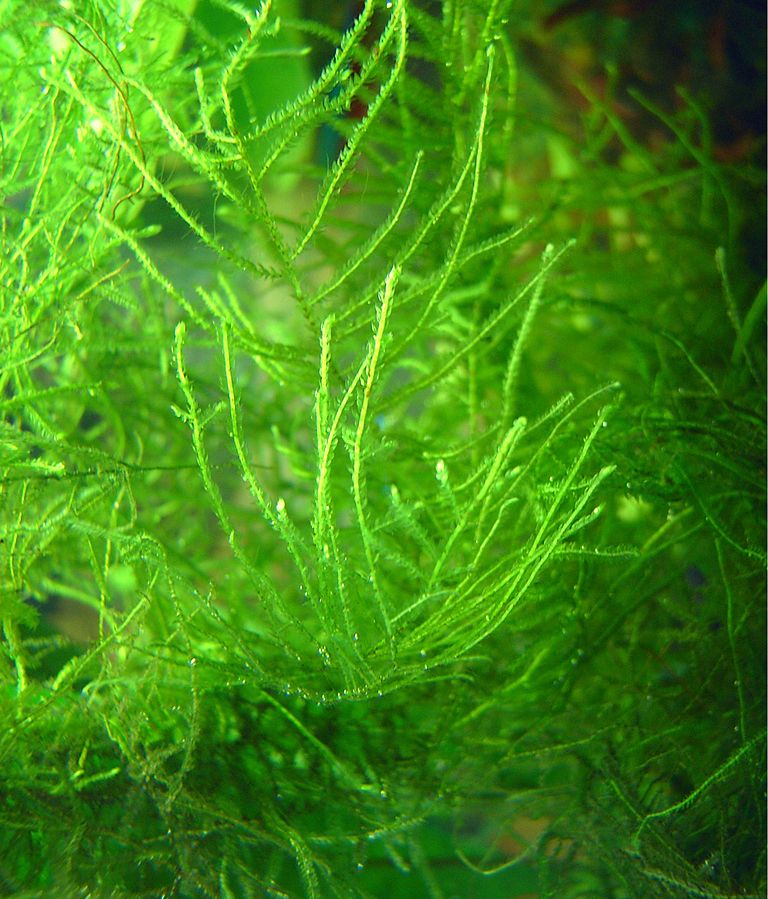
Whenever you need an entirely green cover over your substrate, pick Java Moss.
They are hardy and attractive column feeders that can readily latch onto rocks, driftwood, and perfectly sized gravel for a striking display.
Java Moss is a lot more than just the green look, readily compatible with most if not all the freshwater fish you will want to introduce to the same tank.
Don’t worry about stringent care requirements, given the Java Moss will readily suck essential nutrients using its long tendrils.
14. Waterwheel Plant
The waterwheel is one of those plants that don’t need photosynthesis to thrive. They are natural carnivores and will be an interesting addition to the tank.
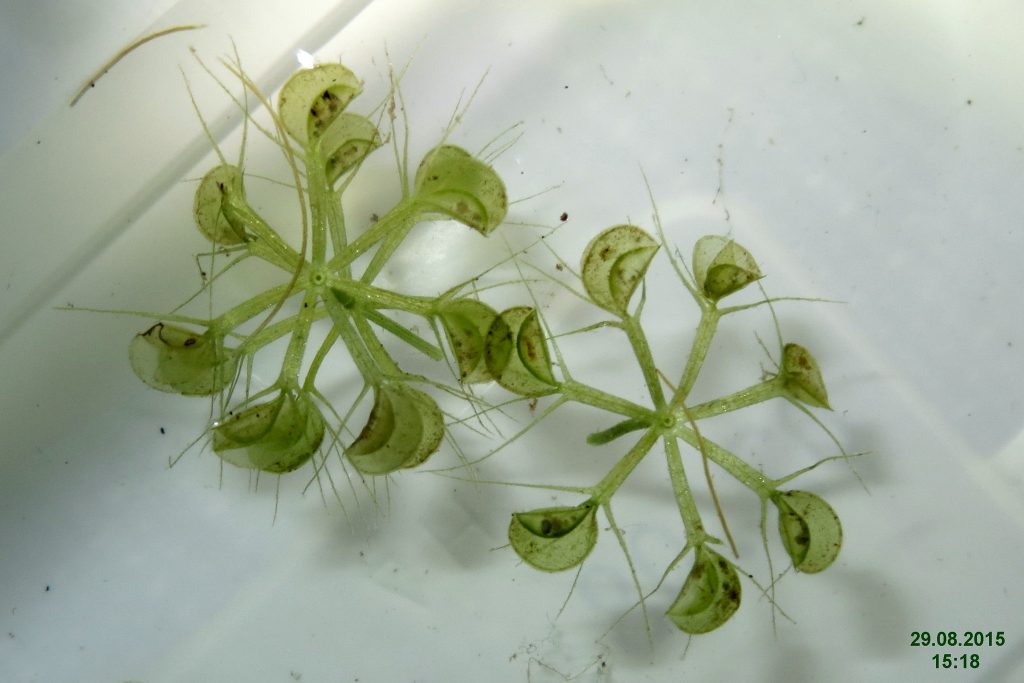
The carnivorous trait, in particular, is quite interesting to watch. Unfortunately, it has also acted as a major turn-off for many aquarists.
So, to set it straight, your fish will be safe with Waterwheel plants in the same tank. Why? Because these plants only target small planktons and microorganisms.
Now, here’s where it gets a little complicated. Waterwheels need a reliable food source to thrive at home with their carnivorous predisposition.
And many a time, aquarists are torn between feeding their favorite pet fish and satisfying the needs of their blossoming Waterwheel plant.
While zooplanktons are readily available, introducing them to the tank could also mean disturbing the water chemistry, putting the lives of your favorite pet fish at risk. This is a hard decision to make, and we will leave it to you when the time comes.
15. Guppy Grass
Guppy grass can be planted in any tank. However, they are more effective as part of nursery tanks, housing popular live-bearing fish like the Guppies.

Also, they are ideal for shrimps because they create a lot of hiding spots that these little critters greatly appreciate.
Guppy grass isn’t bothered by the lighting conditions. However, they show a beautiful dark green coloration when planted inside a low-light aquarium, indicating a healthy plant.
The Guppy grass requires regular trimming, lest they take over the home aquarium as part of general care. Its flexibility allows it to thrive inside many aquariums, with a typical plant readily tolerating temperatures up to 85°F.
16. Pelia
Pelia Moss, simply called Pelia, is many aquarists’ favorite plant for effortless aquascaping. They can spread inside the tank, given their steady growth rate within a short period.

Unlike the Java Moss, the Pelia variety won’t latch onto rocks and driftwood inside the tank, instead of creating a strong base that’s perfect for many fish species.
Despite its fast growth rate, the Pelia Moss is known as one of the most delicate very low light aquarium plants. Accordingly, many aquarists choose to support them with cotton or nylon to encourage proper growth.
Naturally, Pelia Moss is a column feeder that readily flourishes under different conditions without negatively impacting the water chemistry.
17. Cryptocoryne Usteriana
Cryptocoryne usteriana is a broad-leafed aquatic plant that’s just as unique as its name. It is a natural root feeder with the right fertilizer and a moderately sized substrate.

Even though it is a slow-growing plant, a typical usteriana can reach an optimal size of 20 inches with quality care.
Generally, Cryptocoryne usteriana requires little to no maintenance, even if they may usually benefit from occasional trimming to maintain their perfect shape.
From the first time they were introduced to the aquarium hobby, Cryptocoryne usteriana has been many people’s favorite choice because it tolerates low lighting conditions with a readymade shelter for any small, timid fish on sight.
Its broad leaves will have beautiful green or brown coloring.
18. Cryptocoryne Spiralis
Crypt spiralis, short form for Cryptocoryne spiralis, is the term you will frequently hear in the aquarium hobby. Like most plants of the Crypt genus, the Crypt spiralis is easily recognized by its ruffled leaves.

Such leaves are long and slender, sometimes reaching the water surface with proper maintenance. While it’s one of the best aquatic plants for low lighting conditions, the Crypt spiralis has specific requirements that will always prove challenging to newbie aquarists.
For instance, Crypt spiralis thrive with an iron-rich substrate, and as much as that’s achievable at home, it can affect the water chemistry.
On the same note, these plants have strict temperature requirements that should be maintained between 75°F-82°F. Again, that can be difficult to achieve in a standard aquarium, especially if you are a beginner aquarist.
19. Cryptocoryne Wendtii
Cryptocoryne wendtii is another member of the broader Crypt genus that’s so easy to care for. They are beginner-friendly aquatic plants with short, broad, ruffled leaves, just like most species in this family.

They are perfectly suited to low-light aquariums, with the leaves growing up to 18 inches with proper maintenance. A significant aspect of Crypt wendtii care involves proper acclimatization.
Unlike most plants on our list, the Crypt wendtii needs sufficient time to adapt to new conditions. That means they can sometimes appear to wither when first introduced to a new tank before recovering their beautiful look just in time to compliment the tank décor.
What’s more, these amazing root feeders require the right substrate to spread evenly at the tank bottom.
20. Cryptocoryne Balansae
Cryptocoryne balansae is strikingly similar to the Crypt spiralis, with thin leaves extending over the water surface. However, their leaves don’t take a spiral-shaped pattern.

Generally, Crypt balansae thrives in bright lighting conditions. But because they are adaptable to any environment, they are also suited to low lighting conditions.
Even then, it should be stated that these plants will look more stunning in high-light environments.
Furthermore, they are natural root feeders in any environment, preferring higher concentrations of nitrogen and phosphorus at any given time.
A well-maintained Crypt balansae will reach a whopping 3 feet in maximum height, but be sure to trim it frequently to maintain its size within the controllable levels.
21. Brazilian Pennywort
Brazilian Pennywort is a beautiful South American aquatic plant with an insanely fast growth rate under the right conditions. It has an attractive look, with light green coloring and round leaves.

Its versatility makes it an excellent option for low-light aquariums, even though it has a steadier growth in high lighting conditions with enough nitrogen and other nutrients. Brazilian Pennywort thrives in warmer temperatures just like it adapts to cold tropical tanks.
As a natural vining plant, the plant leaves can spread all over the substrate or remain below the water surface.
Either way, this beautiful column feeder will be a great inclusion in the aquarium.
22. Rotala Indica
Rotala indica is one of the best column-feeding aquarium plants of the Rotara family with thin leaves and tall stems. It can be fragile inside the aquarium, requiring constant monitoring to reach the optimal size.

However, the Rotala indica’s bushy appearance makes it a great selection for aquascaping. But that’s not the end.
Rotala indica has sturdy roots that can only get stronger with proper anchoring, guaranteeing their safety from the wrath of most aggressive fish like Cichlids.
Don’t let the Rotala indica take over your tank with its steady growth when simple pruning can readily save the situation.
While it’s perfect t for multiple conditions, expect your Rotala indica to become more slender under low lighting conditions, creating just a small bush in the process.
23. Moneywort
Moneywort is a bright green plant with perfectly rounded leaves and grows up to 12 inches in maximum height. It is a great option for small tanks, and its adaptability makes it ideal for aquascaping.

Moneywort doesn’t need stringent care requirements to thrive, and the choice to trim it or not depends on your preferences.
While some aquarists want to maintain their plant to the standard size, there’s no harm in letting your Moneywort reach its optimal size with no interruption.
Generally, Moneywort thrives in moderate lighting conditions, staying between 72°F-82°F. It’s worth mentioning that despite its preference for moderate lighting conditions,
Moneywort remains adaptable to different lighting conditions inside the tank.
24. Parrots Feather
Parrots Feather is a distinct aquatic plant adored by advanced aquarists and newbies alike. Its biggest selling point is its beautiful look, showing off its attractive, thin leaves ideal for aquascaping.

Parrots feather produces thick foliage that evenly spreads all over the tank, making them a great option for any shy fish that needs countless hiding spots.
A typical plant prefers low lighting conditions and a properly fertilized substrate to reach its maximum height.
Generally, the Parrots feather is a root-feeding plant that flourishes with perfectly sized gravel. Also, they need plenty of nutrients that can easily suck from the tank bottom.
25. Rotala Rotundifolia
Rotala rotundifolia is another column feeder of the Rotala plant family with exceptional coloring. It is a beginner-friendly aquatic plant and interesting addition to thriving aquariums.

Rotala rotundifolia is perfect for most freshwater aquarium fish and tolerant of a wide range of conditions starting with temperature.
They form dense shoots and may benefit from frequent trimming lest they become a compact bush inside the tank.
Rotala rotundifolia is usually confused with the more popular Rotala indica, even though the latter has fresh, bright green leaves with intense coloring.
For the best experience, it’s advisable to plant your Rotala rotundifolia plants in groups, creating an eye-catching display you may never see with most species.
26. Hornwort
Next on our list is the Hornwort, scientifically called Ceratophyllum demersum. It enjoys a faster growth rate and is best for large tanks where an aquarist is patient enough to perform regular trimming.

Hornwort has thin, soft shoots to hold freshly laid eggs inside the tank. A typical Hornwort plant is highly adaptable and can quickly take over your tank in no time.
But on the downside, the Hornworts produce chemicals that may stop other plants from growing inside the same tank, which is why they are ideal as the only aquatic plant inside the tank.
It should be stated that the Hornwort is a typical column feeder, benefiting from proper anchoring or as a floating plant over the water surface.
You will be delighted to know that this adaptable New Zealander plant can easily tolerate both cold water and tropical freshwater conditions.
27. Amazon Sword
Amazon Sword is a common aquatic plant grown for its strong roots and lush green leaves that make it a beginner-friendly option in the aquarium hobby.

Sometimes, even the most passionate hobbyists may struggle with its demanding nature, thanks to the specific nutrients it needs to flourish inside the tank. However, that hasn’t affected its popularity in the aquarium community.
The Amazon Sword plant has long, slender leaves that create a striking display inside the tank.
They are more suitable for accommodating most community fish and aren’t necessarily a great option for the Jack Dempsey Cichlids, Oscars, and other aggressive fish that can easily destroy even the most beautiful plants.
A typical plant requires moderate-strong lighting, but with an average size of 12 inches in maximum height, the Amazon Sword plant can take up a lot of space inside the aquarium.
28. Water Wisteria
Hygrophila difformis, commonly called the Water Wisteria, is one of the most interesting plants you will ever find in the aquarium hobby.

It is native to the marshy habitats of Bangladesh, Nepal, India, and Bhutan and measures around 20 inches in maximum height.
Water Wisteria has easy propagation, making it a popular option among newbie aquarists and advanced hobbyists alike. It is known as a perfect low-light aquarium plant and one of the few that display exciting visual changes.
Depending on the environment, the leaves can grow large enough to increase exposure or shrink to add a unique feel to the tank.
What’s more, the Water Wisteria doesn’t seem to have any preferences, and depending on your aquascaping needs, you can either spread it evenly all over the tank substrate or root it deep in the water.
29. Dwarf Sagittaria
Dwarf Sagittaria is another low-light aquarium plant readily available to newbie aquarists. You should grow it as part of a ground cover to create a carpet-like appearance on top of the substrate.

However, Dwarf Sagittaria requires a nutrient-rich substrate and benefits from the right fertilizer.
A well-maintained Dwarf Sagittaria will easily reach 12 inches in maximum height. But it’s worth mentioning that even with its hardiness, the Dwarf Sagittaria requires proper maintenance to create a beautiful carpet-like layer inside the tank.
Fortunately, that only entails frequent trimming and moderate lighting.
30. Lemon Bacopa
Bacopa caroliniana, or Lemon Bacopa, is a charming member of the Scrophulariaceae family that can be an interesting addition to backyard ponds.

Like most plants from this family, Lemon Bacopa has a slow growth rate that may sometimes rely on additional plant fertilizer and CO2 supplementation.
A backyard pond allows easy blossoming because the typical environment is richly filled with nutrients, easily supporting plant growth.
Lemon Bacopas grow everywhere, as long as the standard lighting, substrate, and water parameters match their needs. You can use it as a floating option while thriving in brackish waters if necessary.
Be sure to maintain your plant at the right height to prevent it from overtaking the aquarium.
31. Ceylon Hygro
Ceylon hygro is another adaptable aquatic plant that does well in low lighting conditions. It is not as popular as the Green hygro variety but can be a wonderful addition to most home aquariums.

Typically, a Ceylon hygro has slender leaves with a beautiful all-green appearance that can be a joy to watch inside the tank.
A significant advantage of introducing Ceylon hygro to your tank is the fact they provide ample swimming space inside the aquarium, giving your pet fish ample protection at all times.
Let’s just say it can be a stress reliever to your favorite pet fish.
32. Banana Plant
The banana plant is an odd-looking aquatic plant rightfully named for the thick, curved roots that almost resemble an actual banana. It is another popular choice if you value rarity inside the tank.

The Banana plant is endemic to the slow-flowing waters of the southeast USA. It is a great option for newbie aquarists looking to add a distinctive look inside their aquariums.
They are quite hardy and versatile, requiring low maintenance every time you introduce them to your aquarium.
Precisely, Banana plants require standard tropical temperatures ranging from 68°F-82°F with low to high lighting conditions and nutritious fertilizer at least quarterly.
33. Duckweed
Duckweed is a popular floating aquarium plant that is good for low light conditions. It is another for novice aquarists and doesn’t require an external light source when planted at home.

One of the biggest advantages of having Duckweed inside the tank is that it suppresses unwanted algal growth, lending a hand in general tank maintenance.
With the lush green carpet-like appearance, Duckweed offers much-needed protection to your invertebrates, amphibians, and other smaller, shy fish inside the tank.
Of course, Duckweed is synonymous with proper maintenance, and the earlier you understand the care guidelines, the easier it becomes to guarantee their health.
34. Bladderwort
Utricularia graminifolia, commonly called Bladderwort, is an interesting carnivorous plant ideal for home aquariums.

Like the aforementioned Duckweed, this plant is ideal for carpeting the aquarium, giving your fish an added cover that doubles as a decorative element.
Of course, the carnivorous tag can make them intimidating to some aquarists. But always remember that the Bladderwort only feeds on small insects.
So, your favorite pet fish and other invertebrates will be safe inside the tank. We won’t get into more detail about its carnivorous trait just yet, but if you need a unique plant that can survive off little light inside the tank, the Bladderwort should top your list of searches.
35. Peacock Moss
Now it’s only right that we finish with the best. The last plant on our list is probably the most recent inclusion of low light aquatic plants, featuring beautiful bluish-green leaves sometimes compared to the pine tree.

Peacock Moss creates the perfect hiding spots for your fish, with its attractive coloration adding a new look to the tank.
Generally, Peacock Moss care is easy enough for beginner-level aquarists, given they tolerate cooler conditions with stable temperatures between 65°F-77°F.
This Moss plant is not just loved for its ease of maintenance but the ability to clean the tank water, eliminating all CO2 while releasing sufficient oxygen into the aquarium to support animal life.
Final Thoughts
Introducing the right aquarium plants to a fish tank is much more than just a way to enhance your favorite pastime. It is one of the best ways to create a healthy habitat for your favorite pet fish and maintain a healthy population in the long run.
It’s even better if you consider spotless aquarium plants that don’t need light. It is a no-brainer most of the plants on our list are also some of the most popular in the broader aquarium community.
Now that you know the right plant to include in your aquarium, the next step is to pick the right choice that would suit your pet fish and specific design needs. We hope that will be fun!
